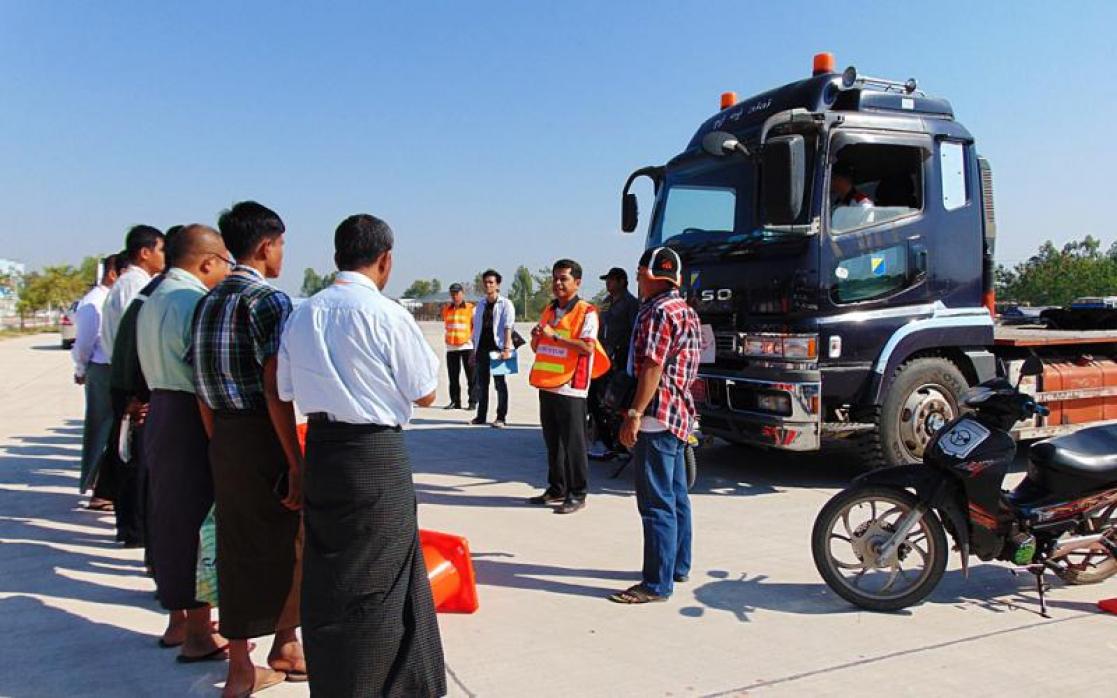Sustainable Freight and Logistics in the Mekong Region

Freight transport and logistics industry represent one of the most dynamic and important sectors of the economy in the Greater Mekong Sub-Region (GMS). Road freight transport in GMS is undertaken by a truck fleet with an average age of 10-15 years, poorly maintained and operated by drivers that did not follow a vocational training but with basic knowledge of signboards and traffic priorities. The sector is highly fragmented, with the majority of truck operators being classed as SMEs or MSMEs, operating small fleets of less than 10 trucks. The logistics system is not yet able to optimise back hauling, with a high rate of empty or partly loaded returns. Against this background, the efficiency, environmental performance and safety of the transport of dangerous goods in this sector are important to ensure sustainable growth while increasing welfare, economic competitiveness and reduce environmental and social impacts.
Objectives:
To improve fuel efficiency in at least 400 micro and SMEs through training and capacity building under different training modules and thereby CO2 emission reduction.
- To improve the safety of dangerous goods transport through regulations, as well as training for both government and private sectors.
- To increase access to finance for SMEs in the logistics sector in greening and freight and logistics.
- To promote labelling scheme on Green freight, and other sustainable consumption and production (SCP) incentive measures in freight, transport and logistics.
Results:
- Fuel efficiency is improved thought in at least 400 micro and SMEs, contributing to CO2 emission reduction of 10-15% by 2019.
- Dangerous goods transport is improved in 80 SMEs.
- 30 investment plans are developed for micro and SMEs for accessing finance.
- More than 40 SMEs are certified with Green Freight Asia-label and at least two countries have developed national action plans for “sustainable freight and logistics”; FRETA national member associations provide services to their members for labelling; policy recommendations of the Action have been taken up by national/regional bodies.
Improving fuel consumption through Eco-driving techniques

"Myanmar is not an industrial country. The economic growth has been mainly generated by a large agriculture sector which accounts for about 35% of GDP, with services. Major sectors include processing, manufacturing, construction and transportation. Transport still plays an important role to move either people and goods throughout the country and 80% of commodity movement happens on the roads. Since we have been insulated from global markets for long time, we have many things to improve. For example, our vehicle fleet is old and in poor condition.
Almost 40,000 trucks operate in Myanmar are second hand from Japan and Korea. This is worsened by poor road condition, and poor driving pattern. This is why MIFFA strongly cooperates with Green Freight project to encourage our members and non-members to join project activities. Learning from other countries like Thailand, Myanmar has gained a lot of knowledge and experiences to improve our professional skills, Consequently, we aim to improve our business performance and sector development."
Mr. Aung Khin Myint, President of Myanmar Freight Forwarders Association, Myanmar
"Recently, Cross Border Transport becomes more and more important for economic development. One country can’t stand alone and compete with each other. Thus, all countries in this region have joined hands and created a cooperative development to increase competitiveness altogether. One essential input for this positive development is of course transport of dangerous goods or hazardous materials. When these dangerous goods are traded and transported, it is important to protect the life and the health of people and of the environment. To make the transport of dangerous goods safe for everyone, we need two things. First, we need good policies and regulations in all countries. And second, we need good capacity among companies and authorities to follow the regulations.
From a public policy perspective, we must also recognise that safer transport of Dangerous Goods does not only ensure a good quality of life and a greener planet – it also helps meeting several of the global Sustainable Development Goals which all governments have agreed to. Another key fact that drives trade and transport within and between countries in the region is of course the regional economic integration process. It means that neighbouring countries remove trade barriers and that they enter into agreements in order to upgrade their cooperation through common institutions and rules."
Mr. Friedel Sehlleier, Deputy Project Director - Energy Efficiency and Climate Change Mitigation in the Land Transport Sector in the ASEAN Region - German International Cooperation
"After training, our driver has shared the knowledge with other drivers in the company, especially on three main technical aspects. Firstly, how to get in and get off the truck systematically and safely. Secondly, it’s about blind spots to avoid unexpected accidents. The last one is on how to change gear at low rpm., use engine braking effectively and gradually increase speed to save fuel. Previously, our driver drove 14 km per gallon, but after applying Eco driving techniques, our driver drives 16 km per gallon for Yangon Taunggyi trips. So, this training is really useful for company to save diesel consumption and money."
Mr.U Kyin Thein, Managing Director of Htun Padetha Freight Transport
Project Fiche
EU Contracted Amount: EUR 2 160 000.00
Total cost: EUR 2 400 000.00
Duration: February 2016 - January 2019
Implementing organisation: DEUTSCHE GESELLSCHAFT FUR INTERNATIONALE ZUSAMMENARBEIT (GIZ) GMBH
Nature: Action Grants
Funding instrument: Development Cooperation Instrument (DCI)
Facts and figures
- 80% of commodity transport is on roads
- Almost 40 000 trucks operate in Myanmar
